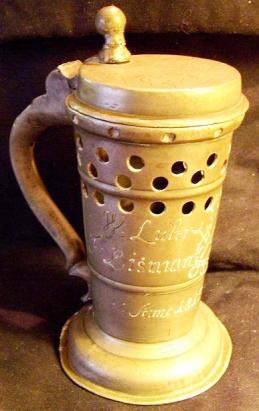
A German pewter lidded “Vexerkrug” (one of the original puzzle vessels in Europe – but not a mug.) Dated 1813. [FWTD] This might rate as a “7” on the Smith-Parator scale. (If it were a bit older it would be an “8”.) These are highly sought after in Germany / Europe.
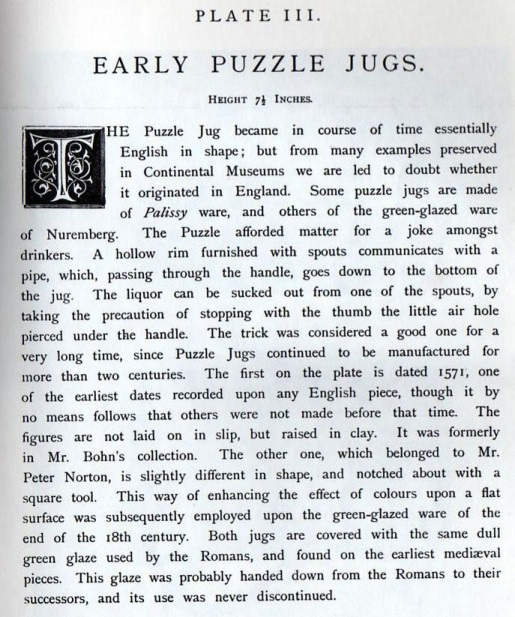
Above ▲. An old English essay about “Puzzle Jugs” (One may have to enlarge to read.)
For info on one of the the oldest Puzzle Jugs in existance, please see: http://www.bbc.co.uk/ahistoryoftheworld/objects/gsTBY1J2T9KVyP1I3AgmSA
For an excellent video on the making of a puzzle jug / mug presented by The V & A Museum in England, see: http://www.wimp.com/puzzlejug/
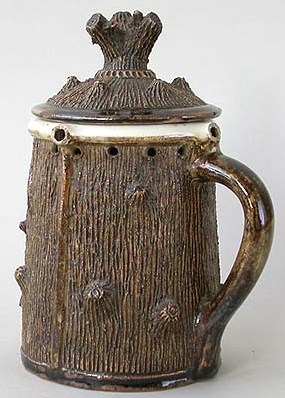 A pottery German [?] puzzle “stein” with a set-on-lid (very unusual!). Circa 1870. This might rate as a “5” on the Smith-Parator scale.
A pottery German [?] puzzle “stein” with a set-on-lid (very unusual!). Circa 1870. This might rate as a “5” on the Smith-Parator scale. 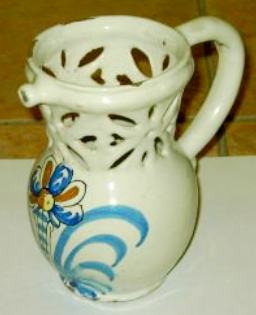 Original, antique English puzzle jug, Ca, 1700’s. Probably from Leeds. This one solves the problem of which nipple to try to use on the German examples. Sold for over 1/2 K’$’. This might rate as a “5.5 ” on the Smith-Parator scale. Also see: “Crest-ware” in the Compendium.
Original, antique English puzzle jug, Ca, 1700’s. Probably from Leeds. This one solves the problem of which nipple to try to use on the German examples. Sold for over 1/2 K’$’. This might rate as a “5.5 ” on the Smith-Parator scale. Also see: “Crest-ware” in the Compendium. 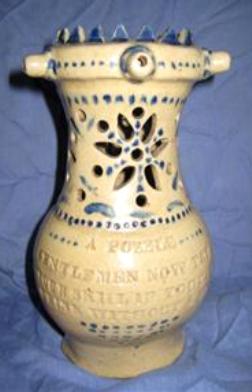 .
. 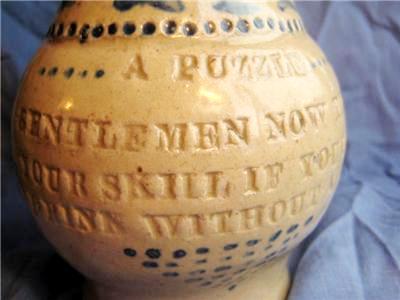 ▲- An English stoneware “Puzzle jug”: but called 19th century; notice the straight lined stamped in words. This might rate as a “5” on the Smith-Parator scale.
▲- An English stoneware “Puzzle jug”: but called 19th century; notice the straight lined stamped in words. This might rate as a “5” on the Smith-Parator scale.  Another English stoneware jug from Lambeth (London.) Mid 1800’s. Very nice workmanship. This might rate as a “5.5” on the Smith-Parator scale. FOR AN INTERESTING VIEW OF A SMALL COLLECTION OF PUZZLE JUGS, (MOSTLY ENGLISH) PLEASE SEE: http://www.fitzmuseum.cam.ac.uk/explorer/index.php?do=Search&qu=CM.2224-2003&size=10&from=10
Another English stoneware jug from Lambeth (London.) Mid 1800’s. Very nice workmanship. This might rate as a “5.5” on the Smith-Parator scale. FOR AN INTERESTING VIEW OF A SMALL COLLECTION OF PUZZLE JUGS, (MOSTLY ENGLISH) PLEASE SEE: http://www.fitzmuseum.cam.ac.uk/explorer/index.php?do=Search&qu=CM.2224-2003&size=10&from=10 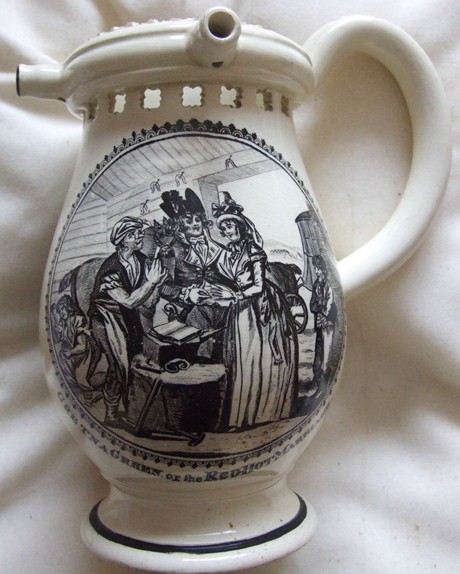 .
. 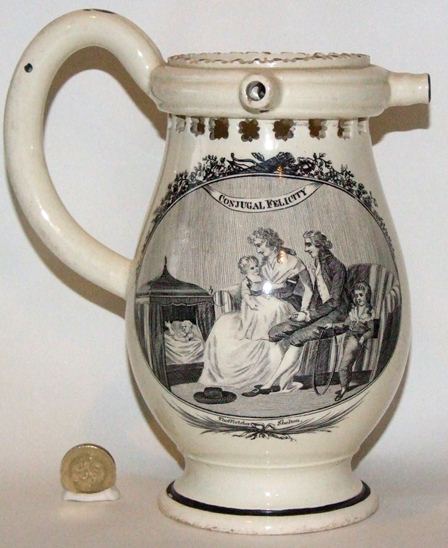 ▲. A marked Thos. Fletcher, Shelton” (1795 – 1820) puzzle jug. This might rate as a “7” on the Smith-Parator scale. [Photos compliment of Mr. PM, in England.]
▲. A marked Thos. Fletcher, Shelton” (1795 – 1820) puzzle jug. This might rate as a “7” on the Smith-Parator scale. [Photos compliment of Mr. PM, in England.] 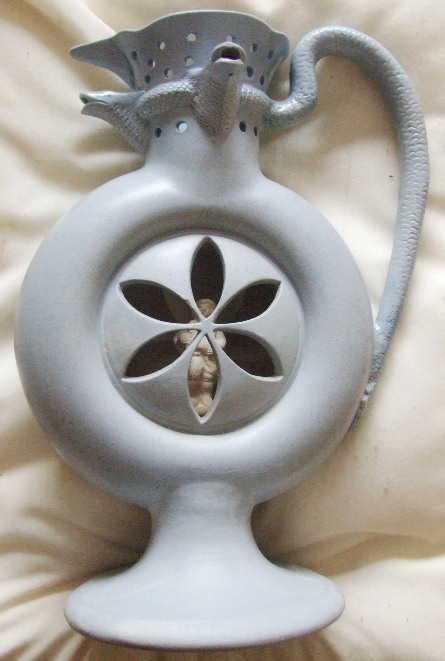 Leeds Pottery England. This might rate as a “7.5” on the Smith-Parator scale. (Photos compliment of Mr. PM, in England.)
Leeds Pottery England. This might rate as a “7.5” on the Smith-Parator scale. (Photos compliment of Mr. PM, in England.) 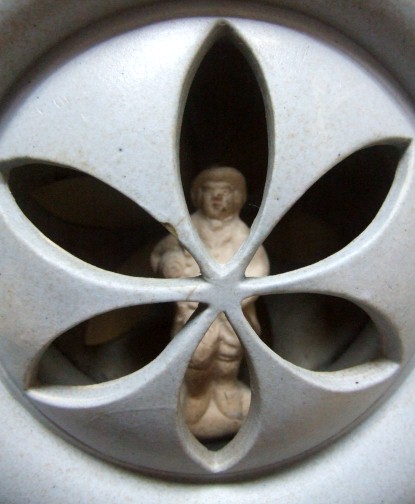
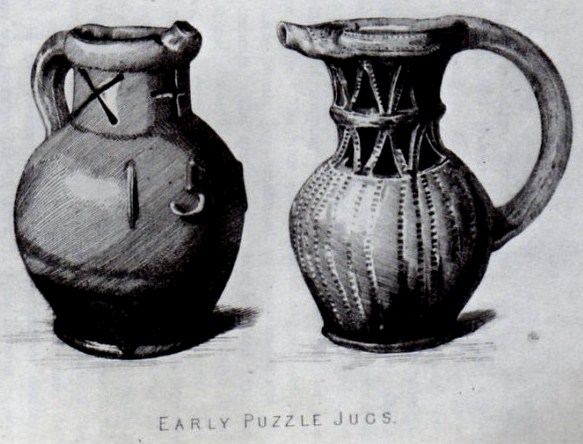
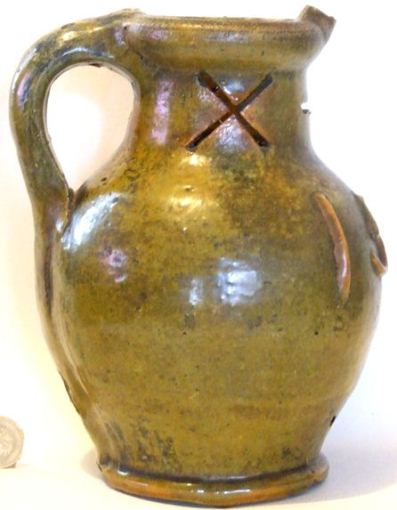
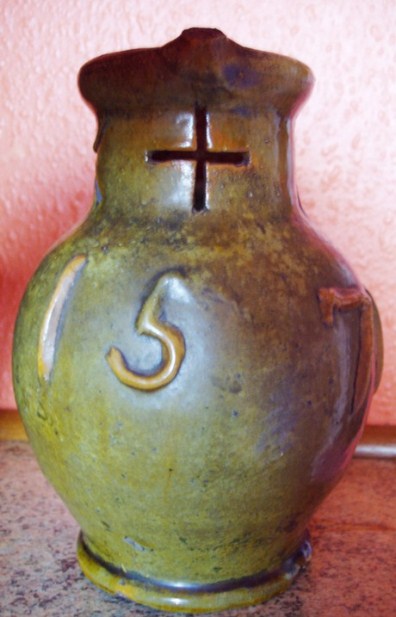
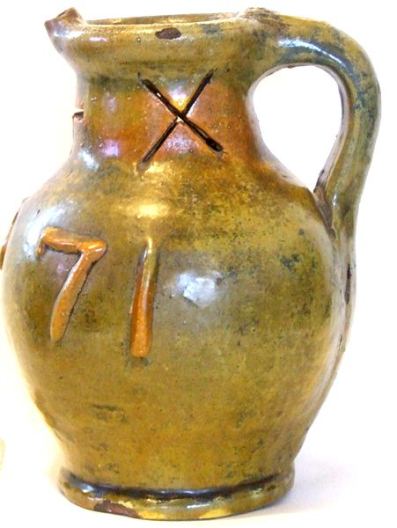 The above 4 photos are compliments of Mr. PM, in England. This might rate as an “8” on t
The above 4 photos are compliments of Mr. PM, in England. This might rate as an “8” on t
he Smith-Parator scale. [Editor’s note: the folowing brief article is from one of my site’s admirer whose pieces can be found above (Mr. PM’s) who lives in England.”] I purchased the jug (shown above) many years ago, and have done a huge amount of research into its history and date ?. This is what i have found out so far.” “There is one with the same date on in the Victoria and Albert Museum in London, it is slightly smaller than mine but they were hand made. There is also another in the Fitzwilliam museum in Cambridge, again smaller than mine. i have a third one, and to my knowledge the only one not in a museum (the other 2 have both been in the museums for over 100 years i have traced their [the three of them?] history back through previous collections and museums to about 1850. My jug was once in the collection of “Louis Marc Solon.” A very important potter himself ; he was the Minton (pottery) pate sur pate specialist. I have found the auction catalog from 1912 when his collection was sold and my jug fetched £10 and 10 shillings, a lot of money at that time! The jug was also drawn and described by him in his book; “The Art of the Old English Potter, 1883.” and in a “Connoisseur Magazine” of 1901, where he (Solon) describes the jug as one of the earliest dated items of English pottery. He, Solon, purchased it from the collection of “Henry George Boh,” a wealthy publisher of books and a lecturer on pottery and porcelain. He was one of the very early collectors from the 1820s -1880s who was buying up old pottery when no one really had any interest in it. This jug has also been in many more publications due to the very early date. The jug itself is a single spouted puzzle jug, in a “tudor green” lead glaze. The neck is pierced with a cross and saltires.and 200mm tall. It is dated “1571.” The date is applied in clay to the front of the jug. On close insection the actual earthenware has large inclusions as it would of done at that time, possibly dug straight from the ground. In the 1980s there was a dig in the Donyatt area in Devon, where jugs like this were known to be made, although none dated as early as this. (If one looks up Donyatt puzzle jugs on the internet you will see a similarity.) But because they didn’t find any matching shards or wasters, they believed that the 3 dated examples were fakes, and that they were made in the 1860s. They=? contacted the Fitzwilliam Museum and told them there/ their jug / which jug ? was a fake and made in the 1860s by Edward Bingham at the Castle Headingham pottery. I then contacted the Fitzwilliam Museum and told them about my research, and now due to this, on that museum’s webpage, it has (states): 16th century or 19th century; It seems strange that they [THE MUSEUM?] would come to the fake conclusion, based on not finding any comparable shards, as they = ? dont even know if the 3 dated examples were from that area and could just of easily been made at the other end of the country to Devon. Anyway obviously I can’t prove the exact date of the jugs, but i have traced the history of mine back farther than when they thought the jugs had been made, so I know they =?: are wrong about that. They also mentioned that they thought that they were made at Castle Headingham, as he (Binghamton} made early dated copies of medieval wares, but i also have 3 pieces of Castle Headingham wares and when they (these pieces) are next to the dated jug, they are different in every way glaze,colour, wear, clay type, etc. I have lots more things I have found out about it, but I think to prove the date the only option would be a Oxford tlt test,*** maybe one day I will.” *** Editor’s note: I have no idea what that is ! 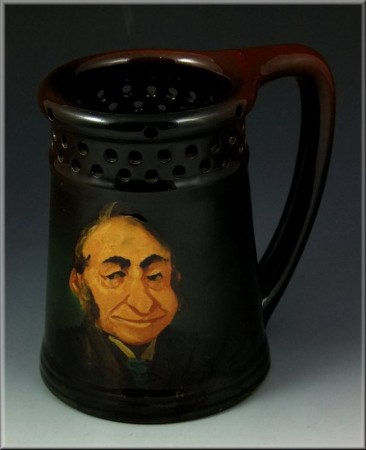 Bruce Horsfall [ARTIST], 19thC Rookwood, standard glaze “puzzle mug.” This might rate as a “5.5” on the Smith-Parator scale, only because of who made it.
Bruce Horsfall [ARTIST], 19thC Rookwood, standard glaze “puzzle mug.” This might rate as a “5.5” on the Smith-Parator scale, only because of who made it. 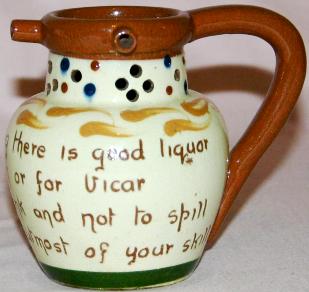 “Solve the Puzzle” / “Within this jug there is good liquor” / “Fit for Parson or for Vicar” / “But how to drink and not to spill” / “Will try the utmost of your skill.” These are French I think and referred to as “Motto ware jugs.” This little one might rate as a “3 ” on the Smith-Parator scale.
“Solve the Puzzle” / “Within this jug there is good liquor” / “Fit for Parson or for Vicar” / “But how to drink and not to spill” / “Will try the utmost of your skill.” These are French I think and referred to as “Motto ware jugs.” This little one might rate as a “3 ” on the Smith-Parator scale. 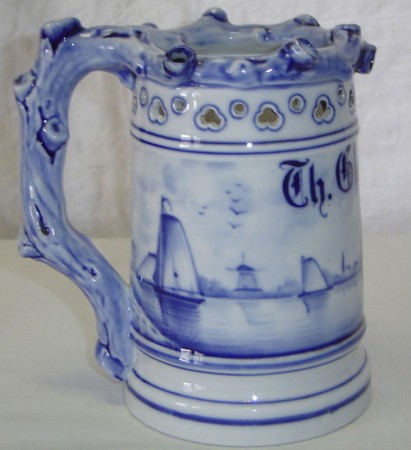 .
. 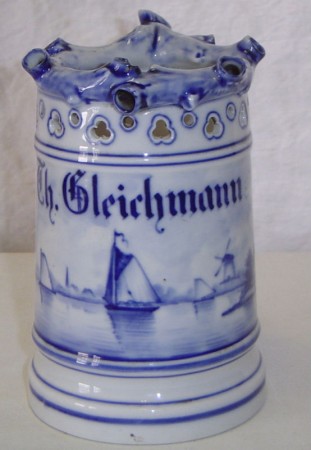 Rauenstein, Thuringia (1850-1897.) Blue & white Delft-type decoration of boats and windmills. Marked with maker’s name. This body is the same or almost, as the Royal Dux mugs shown judt below. I am not certain of any connection between the two firms .Anyone of the resdrs know and would like to share?? This might rate as a “5” on the Smith- Parator scale.
Rauenstein, Thuringia (1850-1897.) Blue & white Delft-type decoration of boats and windmills. Marked with maker’s name. This body is the same or almost, as the Royal Dux mugs shown judt below. I am not certain of any connection between the two firms .Anyone of the resdrs know and would like to share?? This might rate as a “5” on the Smith- Parator scale. 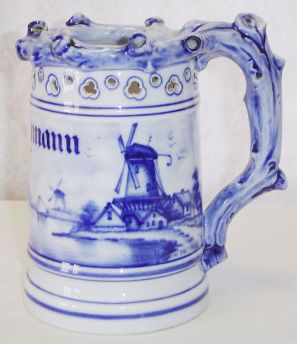 >
>
; 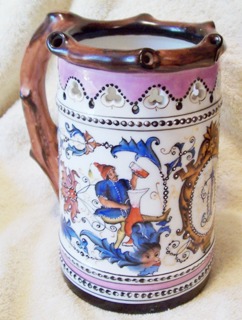 Highly decorative porcelain puzzle mug. Applied enamel beads going around the body, gnomes drinking and monogrammed. A nice one to own. Royal Dux I believe! Circa 1885. [FWTD] This might rate as a “5” on the Smith-Parator scale. ROYAL DUX HISTORY — Royal Dux Porcelain Royal Dux Porcelain has been produced since 1853, in the small town of Duchcov, located about two hours to the North West of Prague, the capital city of the recently formed Czech Republic. From 1918 until December 31st 1992 the country was known as Czechoslovakia, situated behind the so called “Iron Curtain” from 1948 till 1990. As the Berlin Wall crumbled so did the hard line communist government in Czechoslovakia. The “Velvet Revolution” (so called because of its lack of blood-shed and violence) began in November 1989, in the streets of Prague, initiated by students, but supported by the entire country. In January of 1990 Vaclav Havel (the famous dissident writer) was elected president of a free Czechoslovakia. However, in the winter of 1992 the Czech and Slovak factions decided to split and form two separate countries, The Czech Republic and the Slovak Republic. This split has become known as the “Velvet Divorce”. Today the Czech Republic is a thriving country on the rocky road back to capitalism. Tourism is absolutely unbelievable, with millions of visitors per year. The country is very beautiful and full of historical buildings, castles and natural wonders with at least five different sites, (one of them being the city of Prague) protected by UNESCO. From Nazi occupation just before World War II, all the way through more than forty years of communist tyranny, the Royal Dux factory never stopped to produce the beautiful porcelain pieces for which they are so famous. Now, no longer part of a huge government owned monopoly, Royal Dux Porcelain has now been fully privatized and is making great strides to return to its once impressive past. Although most “Westerners” don’t realize it, the short time span between World War I and World War II was all that was needed to give the Czechs a chance to become one of the five wealthiest and most industrialized countries in the world. This era is most often referred to as “The First Republic” and holds a fond place in the hearts of all Czechs. Before the Nazi invasion in 1938 the company had produced over 12,000 different molds and exported beautiful porcelain and faience figurines all around the world. Collectors from all parts of the world are inquiring about the beautiful pieces they have purchased or inherited. What artist? Which Date? Can I find a book about Royal Dux? — are many of the questions we receive via email from our Internet web site www.royaldux.com. Most of the information about the company and its history has been “misplaced” and is not currently at the factory. Old company catalogs and sales information are practically non-existent, and the majority of old molds destroyed during the fifties. However, through much leg-work, by myself and my (Czech) wife, many of the pieces of the Royal Dux puzzle will be put together. Along with new postings on the Royal Dux website an official Royal Dux book is in the works and will be completed the first quarter of 1999. The fall of the Iron Curtain has made it possible for all lovers of fine porcelain art to once again have access to the amazingly wide range of porcelain items that are produced at the Royal Dux factory. However the fall of the communist government in 1990 brought about many new and painful changes which have, at times put the company’s survival in peril. Changes in management and chaos followed the revolution and for a time no one was sure what was going to happen. With the lack of accountability always comes fraud and deception and the Royal Dux factory suffered its share. Huge amounts of inventory “mysteriously” disappeared to customers who just couldn’t be located and company assets went missing without a clue as to who could be the culprits. Now the company is in the hands of private owners who have an agenda to put the company back on its feet. The company is in the process of developing its own sales and marketing strategies, which until now were dictated by government owned trade and export companies located in Prague. At the present, some of the molds dating from before WWII are being brought out of the archives and being revamped for production. New decors and glazing techniques are being used, and the company is making plans to produce “Limited Edition” pieces and to begin concentrating more on the “Collectible” market. Fresh ideas are being examined by the new directors and those that are needed will be implemented as quickly as possible. With plans to attend this year’s “International Collectible Exposition” in Rosemont, Illinois, Royal Dux hopes to make a statement to collectors worldwide that Royal Dux porcelain will indeed take its rightful place among the world’s top collectibles. FROM: http://www.worldcollectorsnet.com/magazine/issue6/iss6p3.html .
Highly decorative porcelain puzzle mug. Applied enamel beads going around the body, gnomes drinking and monogrammed. A nice one to own. Royal Dux I believe! Circa 1885. [FWTD] This might rate as a “5” on the Smith-Parator scale. ROYAL DUX HISTORY — Royal Dux Porcelain Royal Dux Porcelain has been produced since 1853, in the small town of Duchcov, located about two hours to the North West of Prague, the capital city of the recently formed Czech Republic. From 1918 until December 31st 1992 the country was known as Czechoslovakia, situated behind the so called “Iron Curtain” from 1948 till 1990. As the Berlin Wall crumbled so did the hard line communist government in Czechoslovakia. The “Velvet Revolution” (so called because of its lack of blood-shed and violence) began in November 1989, in the streets of Prague, initiated by students, but supported by the entire country. In January of 1990 Vaclav Havel (the famous dissident writer) was elected president of a free Czechoslovakia. However, in the winter of 1992 the Czech and Slovak factions decided to split and form two separate countries, The Czech Republic and the Slovak Republic. This split has become known as the “Velvet Divorce”. Today the Czech Republic is a thriving country on the rocky road back to capitalism. Tourism is absolutely unbelievable, with millions of visitors per year. The country is very beautiful and full of historical buildings, castles and natural wonders with at least five different sites, (one of them being the city of Prague) protected by UNESCO. From Nazi occupation just before World War II, all the way through more than forty years of communist tyranny, the Royal Dux factory never stopped to produce the beautiful porcelain pieces for which they are so famous. Now, no longer part of a huge government owned monopoly, Royal Dux Porcelain has now been fully privatized and is making great strides to return to its once impressive past. Although most “Westerners” don’t realize it, the short time span between World War I and World War II was all that was needed to give the Czechs a chance to become one of the five wealthiest and most industrialized countries in the world. This era is most often referred to as “The First Republic” and holds a fond place in the hearts of all Czechs. Before the Nazi invasion in 1938 the company had produced over 12,000 different molds and exported beautiful porcelain and faience figurines all around the world. Collectors from all parts of the world are inquiring about the beautiful pieces they have purchased or inherited. What artist? Which Date? Can I find a book about Royal Dux? — are many of the questions we receive via email from our Internet web site www.royaldux.com. Most of the information about the company and its history has been “misplaced” and is not currently at the factory. Old company catalogs and sales information are practically non-existent, and the majority of old molds destroyed during the fifties. However, through much leg-work, by myself and my (Czech) wife, many of the pieces of the Royal Dux puzzle will be put together. Along with new postings on the Royal Dux website an official Royal Dux book is in the works and will be completed the first quarter of 1999. The fall of the Iron Curtain has made it possible for all lovers of fine porcelain art to once again have access to the amazingly wide range of porcelain items that are produced at the Royal Dux factory. However the fall of the communist government in 1990 brought about many new and painful changes which have, at times put the company’s survival in peril. Changes in management and chaos followed the revolution and for a time no one was sure what was going to happen. With the lack of accountability always comes fraud and deception and the Royal Dux factory suffered its share. Huge amounts of inventory “mysteriously” disappeared to customers who just couldn’t be located and company assets went missing without a clue as to who could be the culprits. Now the company is in the hands of private owners who have an agenda to put the company back on its feet. The company is in the process of developing its own sales and marketing strategies, which until now were dictated by government owned trade and export companies located in Prague. At the present, some of the molds dating from before WWII are being brought out of the archives and being revamped for production. New decors and glazing techniques are being used, and the company is making plans to produce “Limited Edition” pieces and to begin concentrating more on the “Collectible” market. Fresh ideas are being examined by the new directors and those that are needed will be implemented as quickly as possible. With plans to attend this year’s “International Collectible Exposition” in Rosemont, Illinois, Royal Dux hopes to make a statement to collectors worldwide that Royal Dux porcelain will indeed take its rightful place among the world’s top collectibles. FROM: http://www.worldcollectorsnet.com/magazine/issue6/iss6p3.html . 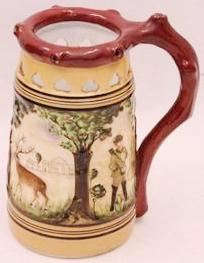 Done by the same firm as above = Royal Dux Notice the nipples and trefoil design are the same as the two above. [FWTD] Not quite as well done as the above, but still nice for a hunting motif. Circa 1890 perhaps. This might rate as a “4.5” on the Smith-Parator scale.
Done by the same firm as above = Royal Dux Notice the nipples and trefoil design are the same as the two above. [FWTD] Not quite as well done as the above, but still nice for a hunting motif. Circa 1890 perhaps. This might rate as a “4.5” on the Smith-Parator scale. 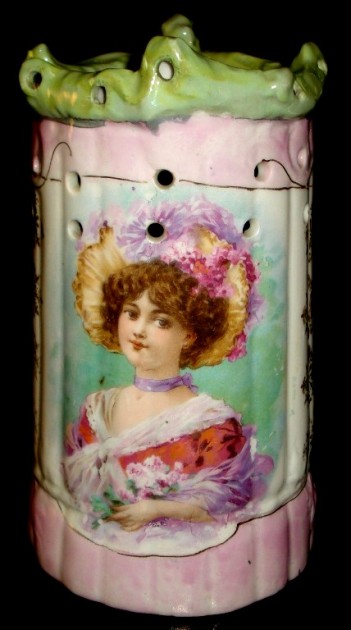
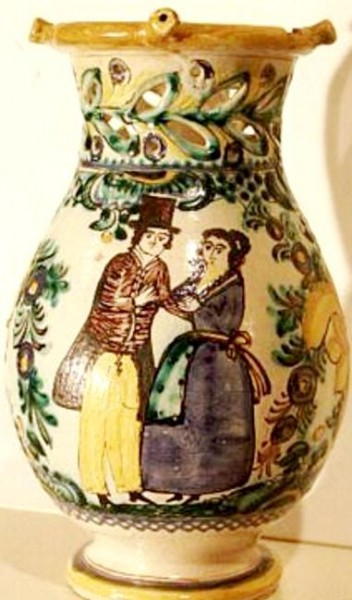 Shown above ▲: A Slovakian fayence /(faience) puzzle jug, Dated 1851. [FWTD] This might rate as a “5” on the Smith- Parator scale.
Shown above ▲: A Slovakian fayence /(faience) puzzle jug, Dated 1851. [FWTD] This might rate as a “5” on the Smith- Parator scale. 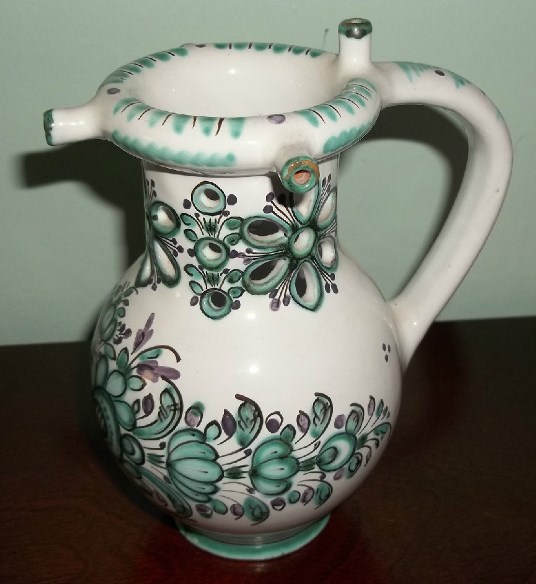 A modern day version done in the same way as the one 150 years ago. One can tell by the brightness of the glaze, with no small chips anywhere, and the freshness of the base ▼.
A modern day version done in the same way as the one 150 years ago. One can tell by the brightness of the glaze, with no small chips anywhere, and the freshness of the base ▼. 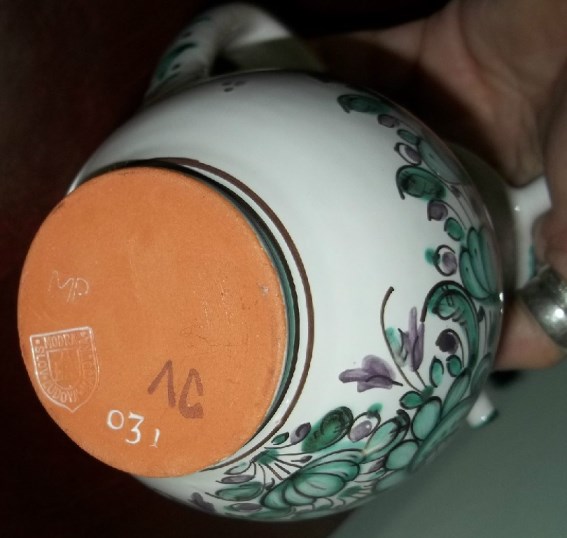
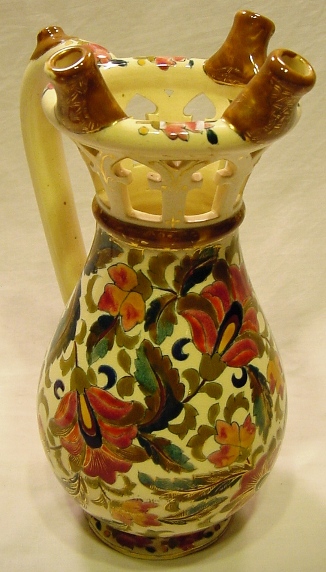 Puzzle jug. Circa 1865. Hungary. This might rate as a “5” on the Smith-Parator scale.
Puzzle jug. Circa 1865. Hungary. This might rate as a “5” on the Smith-Parator scale. 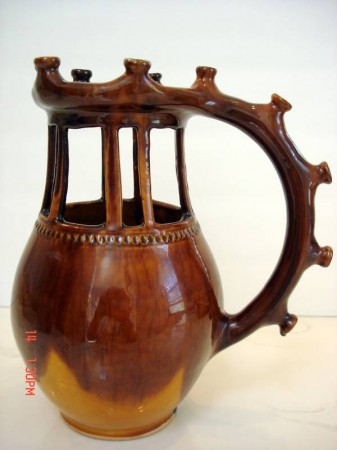 Hungarian, newer but quite different. This might rate as a “4” on the Smith-Parator scale.
Hungarian, newer but quite different. This might rate as a “4” on the Smith-Parator scale. 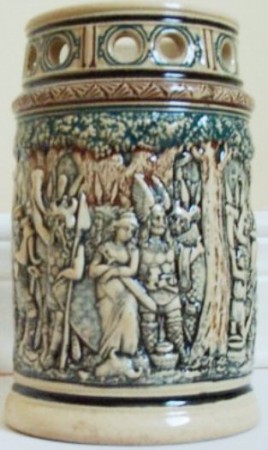 An interesting pottery relief puzzle mug, showing “Hermann and Trusnelda.” This might rate as a “4 ” on the Smith-Parator scale. Maybe more to “Hermann” collectors. Also see: http://www.steveonsteins.com/hermanns-story
An interesting pottery relief puzzle mug, showing “Hermann and Trusnelda.” This might rate as a “4 ” on the Smith-Parator scale. Maybe more to “Hermann” collectors. Also see: http://www.steveonsteins.com/hermanns-story ![RSOS_PUZZLE JUG - English or Dutch [I THINK] - stein blue & white late 18th-early19th century](http://www.steveonsteins.com/wp-content/uploads/2015/02/RSOS_PUZZLE-JUG-English-or-Dutch-I-THINK-stein-blue-white-late-18th-early19th-century-366x630.jpg) Puzzle Stein l set-on-lid variety. Dutch or English late18th, early19th century.
Puzzle Stein l set-on-lid variety. Dutch or English late18th, early19th century. 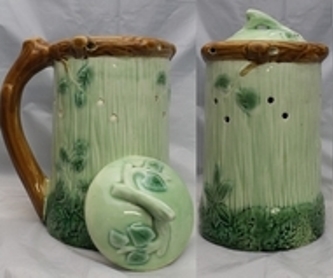 An unusual “puzzel stein” ; ‘set-on-lid’ variety.
An unusual “puzzel stein” ; ‘set-on-lid’ variety. 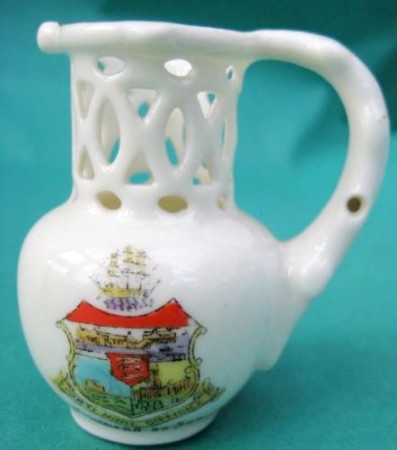
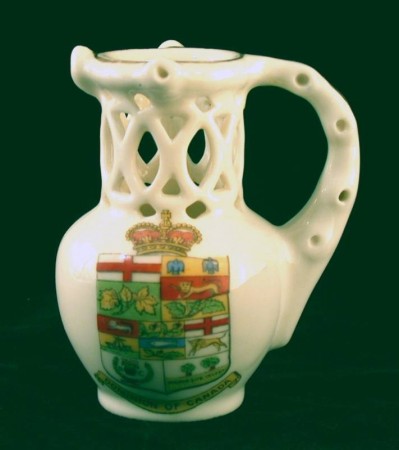 Called “Crestware” in England, these are souvenirs from towns an are collected by the Brits as we Americans collect refrigerator magnets on our travels. These might rate as a “3 ” on the Smith-Parator scale. More in England, perhaps as a status symbol for the family that can travel so much.
Called “Crestware” in England, these are souvenirs from towns an are collected by the Brits as we Americans collect refrigerator magnets on our travels. These might rate as a “3 ” on the Smith-Parator scale. More in England, perhaps as a status symbol for the family that can travel so much. 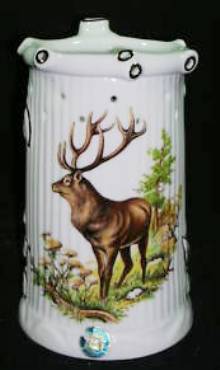 .
. 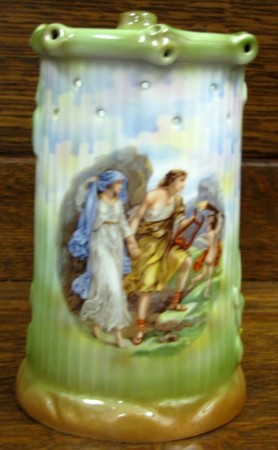 Both ▲ are newer porcelain 1/2 liter PUG “Puzzle mugs” from Germany. Circa 1970 – 2010. They will probably have a draped nude in the lithophane. These both might rate as a “3” on the Smith-Parator scale. (Great gifts.)
Both ▲ are newer porcelain 1/2 liter PUG “Puzzle mugs” from Germany. Circa 1970 – 2010. They will probably have a draped nude in the lithophane. These both might rate as a “3” on the Smith-Parator scale. (Great gifts.) 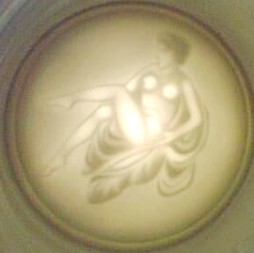
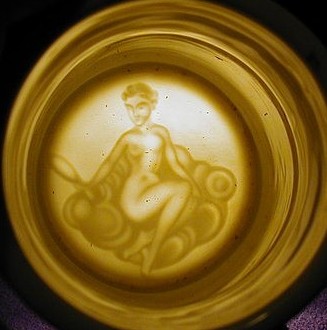
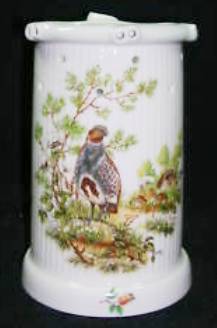 Porcelain. 1/2 liter another PUG design. Unknown country (Probably Germany), but much newer. This might rate as a “3” on the Smith-Parator scale.
Porcelain. 1/2 liter another PUG design. Unknown country (Probably Germany), but much newer. This might rate as a “3” on the Smith-Parator scale. 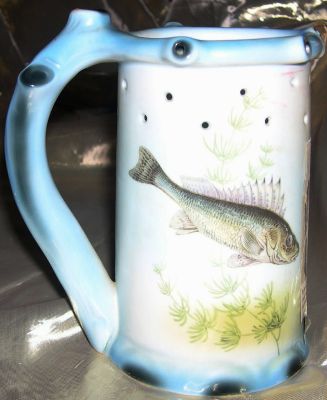 A very modern day porcelain puzzle jug made by “Gerold Porzellen, Germany. Not too well done, but assumed to be functional. This might rate as a “3” on the Smith-Parator scale.
A very modern day porcelain puzzle jug made by “Gerold Porzellen, Germany. Not too well done, but assumed to be functional. This might rate as a “3” on the Smith-Parator scale.
For many more examples go to “Goggle” and enter “Puzzle Jug.” You will be surprized at the variety I believe!
OTHER TYPES OF NOVELTY DRINKING MUGS : For the “brand new” drinking vessel / beer mug collector we find on eBay a new mug made of molded resin. Nicely done though. 5 .5 in high with an interior dimension of 3 in diameter, removable interior metal cup.  For the “brand new” drinking vessel / beer mug collector we find on eBay a new mug made of molded resin. Nicely done though. 5 .5 in high with interior dimension of a 3 in diameter, removable interior metal cup.
For the “brand new” drinking vessel / beer mug collector we find on eBay a new mug made of molded resin. Nicely done though. 5 .5 in high with interior dimension of a 3 in diameter, removable interior metal cup. 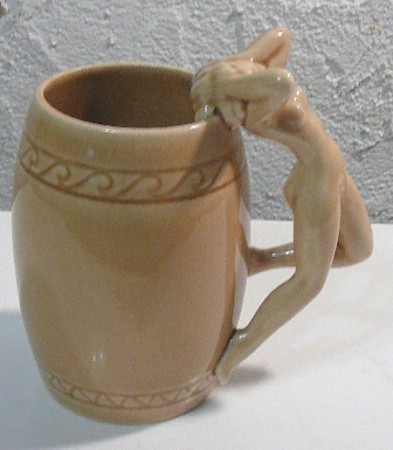 A most favorite rendition (and subject.) There must be hundreds of varieties of the “Nude Handled” mugs. But most found are cheap Japanese pottery “knock offs” of a series of very collectable nude handled mugs which were produced by artist Dorothy Kindell. (see just below ▼) None of these are rated: mostly 2’s or 3’s.
A most favorite rendition (and subject.) There must be hundreds of varieties of the “Nude Handled” mugs. But most found are cheap Japanese pottery “knock offs” of a series of very collectable nude handled mugs which were produced by artist Dorothy Kindell. (see just below ▼) None of these are rated: mostly 2’s or 3’s. 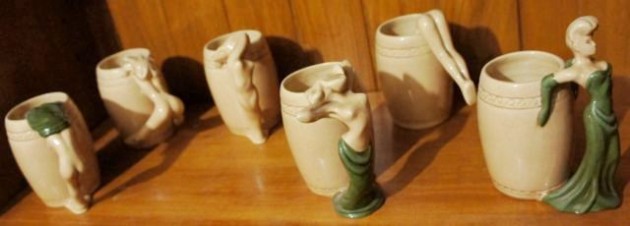 Dorothy Kindell – “The Naughty Potter, ” Art Deco. 1940’s. set of 6 nude, semi nude mugs. These originals which are quite collectable — therefore copied by many might rate as a “5” on the Smith-Parator scale.I am not quite certain I would try to drink beer out of the one back row , far right. In fact I think a few of the heads onnthee might hinder a good mouth to mug seal. A pretty display though . These two “knock offs” are interesting in that they have “panties” on. Most do not.This might rate as a “2” on the Smith-Parator scale.
Dorothy Kindell – “The Naughty Potter, ” Art Deco. 1940’s. set of 6 nude, semi nude mugs. These originals which are quite collectable — therefore copied by many might rate as a “5” on the Smith-Parator scale.I am not quite certain I would try to drink beer out of the one back row , far right. In fact I think a few of the heads onnthee might hinder a good mouth to mug seal. A pretty display though . These two “knock offs” are interesting in that they have “panties” on. Most do not.This might rate as a “2” on the Smith-Parator scale. 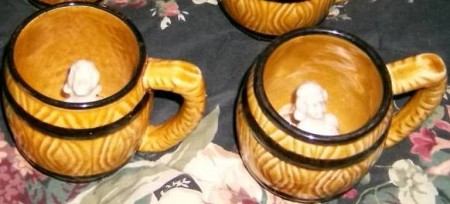 These cheapies are “take offs” of the antique English / European drinking mug that has a frog inside that is only apparent after you drink the liquid down (See example shown far above.) This might rate as a “2” on the Smith-Parator scale.
These cheapies are “take offs” of the antique English / European drinking mug that has a frog inside that is only apparent after you drink the liquid down (See example shown far above.) This might rate as a “2” on the Smith-Parator scale.  .
. 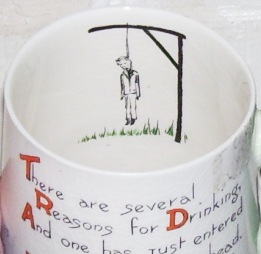 I think this little 3 3/4 inch tall British ceramic mug is ‘a jewel.’ The verse says:
I think this little 3 3/4 inch tall British ceramic mug is ‘a jewel.’ The verse says:
“There are several Reasons for Drinking, And one has just entered my head, If a man can’t Drink when he’s Living , how the H—! can he Drink when he’s Dead?”
Besides the verse it shows “The last drop” logo (with no words) on the inside, and a wreath around a bottle of whiskey with the words: In Loving Memory. Marked “Carlton Ware.” They also made the version below. Circa 1930 -40’s for both. This might rate as a “5” on the Smith-Parator scale. 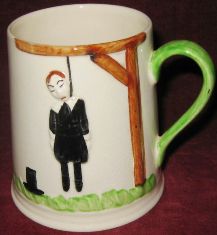
Also marked “Carlton Ware.” This might rate as a “4” on the Smith-Parator scale.
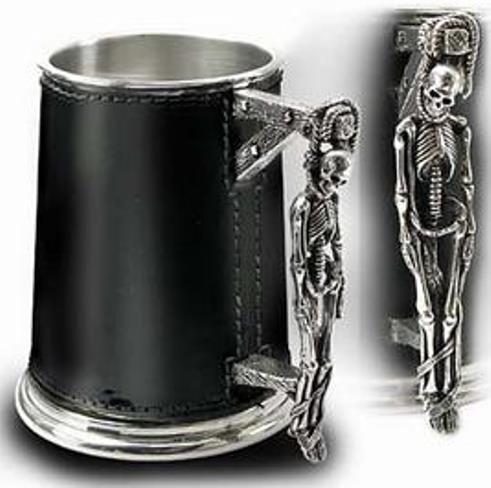
VERY NEW NOVELTY MUGS Leather and polished pewter, English Made to celebrate the hanging of Dick Turpin. Richard “Dick” Turpin (bap. 1705 – 7 April 1739) was an English highwayman whose exploits were romanticised following his execution in York for horse theft. Turpin may have followed his father’s profession as a butcher early in life, but, by the early 1730s, he had joined a gang of deer thieves and, later, became a poacher, burglar, horse thief and killer. He is also known for a fictional 200-mile (320 km) overnight ride from London to York on his horse Black Bess, a story that was made famous by the Victorian novelist William Harrison Ainsworth almost 100 years after Turpin’s death.[Wikipedia:]
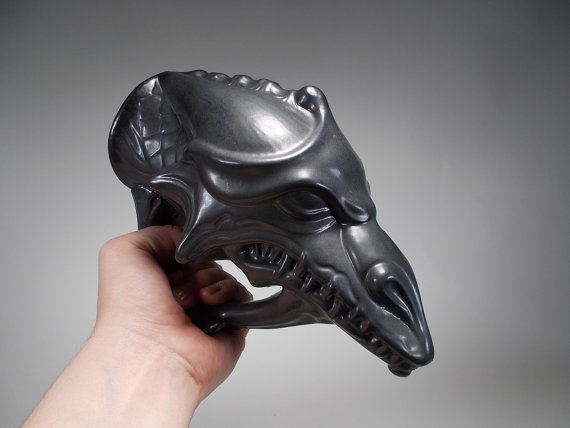
And for the very young generation of beer drinkers; or some character collectors is this new 2013 Fantasy Mug of a Dragon’s head. Just think these will be called antiques in 2113 !!
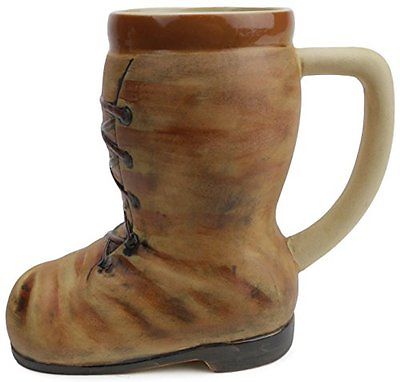
Newest type of “drinking boot,” a mug made to look like a leather hunter’ s boot. Ca. 2010 For the antique types of drinking boots see: See: http://www.steveonsteins.com/the-man-who-can-not-drink-his-boot-full-of-beer-is-not-a-true-bavarian-new-10-13-11
[END – SOK -54- R5] STEVE (STEPHEN) =
 “Ladies; Men have two emotions: Hungry and Horny So, ladies, if you see him without an erection; make him a sandwich .”
“Ladies; Men have two emotions: Hungry and Horny So, ladies, if you see him without an erection; make him a sandwich .”

